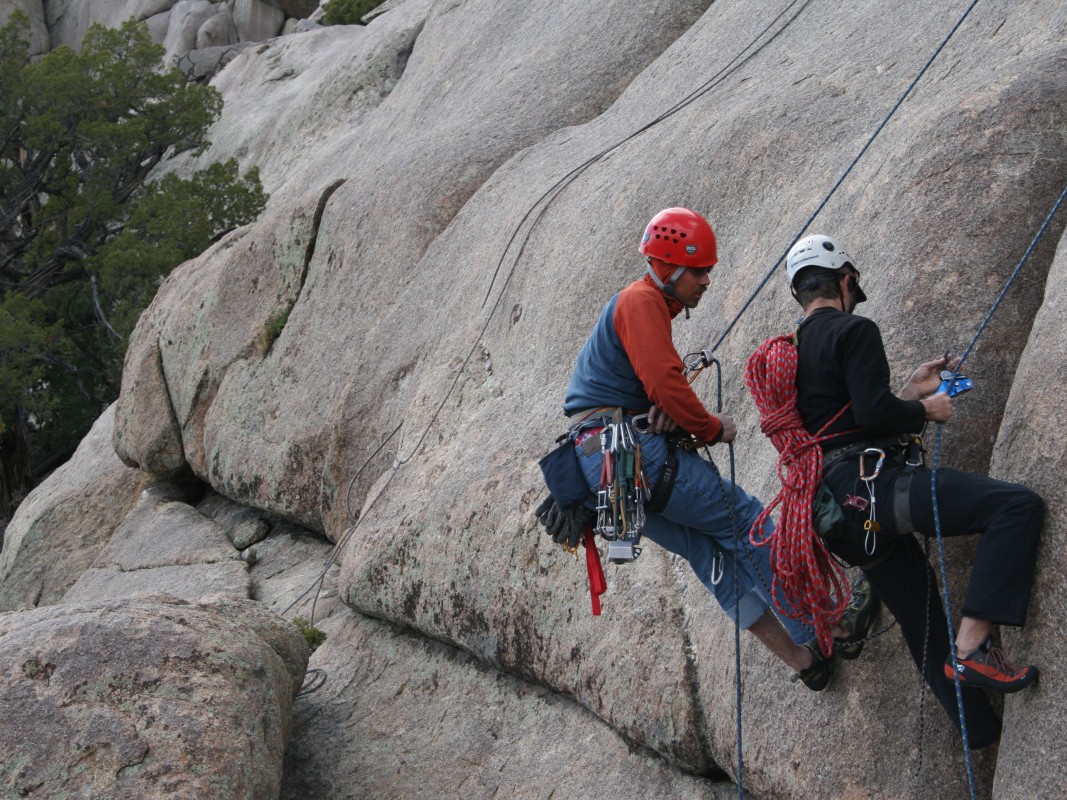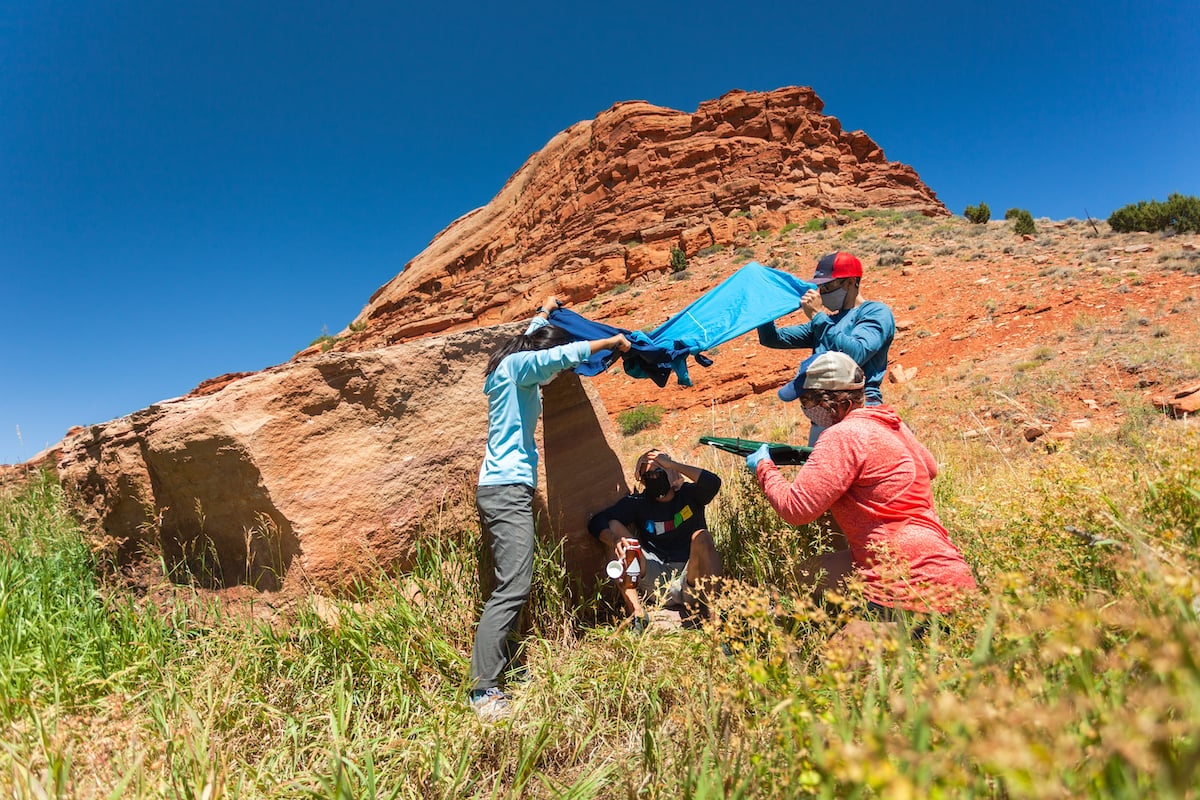Case Study: An Anxious Rappel

The Setting
You’re leading a college spring break backpacking trip in the Arizona desert. On today’s agenda is an afternoon of rappelling practice to prepare for an anticipated technical canyon section later on this route.
The participant is a 19-year-old who has demonstrated anxiety on steep terrain. They have needed a lot of coaching to get through a few of the steep descents. Now, they are 15 feet below the edge on a rappel. They got this far after you spent 20 minutes coaching them over the edge.
It is mid-afternoon and the wind starts blowing dust in their face. They say they are dizzy and going to pass out. You engage the belay line and try to get them to release their brake hand so they can be lowered. It takes several minutes of coaxing before they release their clenched brake hand and you can lower them to the ground.
As you approach the patient you observe they have removed their face mask, which was being worn by everyone in the group as a precaution during the COVID-19 pandemic, and they are surrounded by several anxious people.
They have all moved from the base of the climb into the designated safe zone. You check your mask and glasses, don a pair of gloves, and ask everyone to move away from the patient. You approach the patient, move to their upwind side, reassuringly touch them on the shoulder and begin your assessment.
SOAP Report
Subjective
The patient, a 19-year-old male, complains of dizziness, headache, numb and painful hands, and tingling around their mouth. They say they “can’t breathe.” Patient was slowly lowered to the ground on belay after failing to rappel a section of steep terrain. There is no mechanism for injury.
Objective
Patient Exam
Head to toe exam reveals tingling and numbness in hands and lips, with cramping and abrasions to right hand. Circulation to the hands is normal. Circulation, sensation, and motion (CSM) in the feet are normal. No wheezes or coughing while breathing. No other injuries found.
Vital Signs
|
Time |
3:30 PM |
|
Level of Responsiveness (LOR) |
A+Ox4 |
|
Heart Rate (HR) |
90, strong, regular |
|
Respiratory Rate (RR) |
28, regular, deep |
|
Skin Color, Temperature, Moisture (SCTM) |
Flushed, warm, moist |
|
Blood Pressure (BP) |
Radial pulses present |
|
Pupils |
PERRL (Pupils equal, round, responsive to light) |
|
Temperature (T°) |
Not taken |
History
|
Symptoms |
Patient is emotionally anxious, light headed and dizzy. |
|
Allergies |
They deny allergies, but say they “may have asthma.” |
|
Medications |
They deny taking any medications. They have never used an inhaler. |
|
Pertinent Hx |
Patient has been anxious on steep terrain. |
|
Last in/out |
Patient ate lunch today, is well hydrated, urine has been clear and bowel movements normal. |
|
Events |
Patient developed symptoms while rappelling. |
STOP READING!
What is your assessment and plan? Take a few minutes to figure out your own assessment and make a plan. Don’t cheat—no reading on without answering this first!

Assessment
- Hyperventilation
- Possible asthma attack (all the dust in the air?)
Plan
- Calm the patient. Try to get them to slow their breathing. Move to a shady, wind-protected spot.
Anticipated problems
- Inability to resolve the hyperventilation makes the patient very ill.
The Tale Continues
The patient continues to breathe rapidly and now complains of pain in their hands, which have obvious spasms. They are truly scared. You decline the offer of an asthma inhaler belonging to another participant.
You renew efforts to slow the patient’s breathing by slowly and calmly repeating “breathe in, breathe out.” After twenty minutes their respiratory rate is a steady 12 per minute. You notice that there is no wheezing, which tells you it’s not likely this is asthma. Additionally, you haven’t seen any signs of skin rashes or other allergic responses.
Eventually the hand spasms subside, and the numbness and tingling resolve. At this point the patient is able to don their face mask. The patient is exhausted; so, after cleaning the abrasions on the right hand, likely rope burn, you spend the afternoon resting and hydrating. You probe their history further and find out they have never had an asthma episode, nor have they hyperventilated.
You’re able to explain what you think happened.
The increased breathing with hyperventilation can cause us to exhale carbon dioxide, which alters blood chemistry and triggers tingling, muscle spasms (carpopedal spasms), and sometimes chest pain, which can accompany anxiety, a sense of suffocation without apparent physiological basis, rapid and deep respiration, rapid pulse, dizziness and/or fainting, sweating, and dry mouth.
Treatment is to calm the patient and slow their breathing. Coach the patient to breathe slowly. It may take some time before the symptoms resolve. Breathing into a paper bag, once thought to help increase carbon dioxide in the blood, is no longer a recommended treatment.
Comment from the author:
This case study was revised to describe an approach to patient assessment during this COVID pandemic. Ideally, the rescuer dons mask, glasses and gloves, and the patient wears a mask. People not needed for care were moved away from the patient. In this case, I assumed the patient’s mask may be exacerbating the sense of shortness of breath, so we did not replace it initially. The caregiver moved to the patient’s upwind side, in position to reduce their exposure to whatever the patient may be exhaling, yet able to provide reassuring physical contact. It may also be feasible to sit 6 feet from the patient and make eye contact with them as you coach them to slow their breathing rate.
Keep your skills fresh: Recertify with NOLS Wilderness Medicine.

